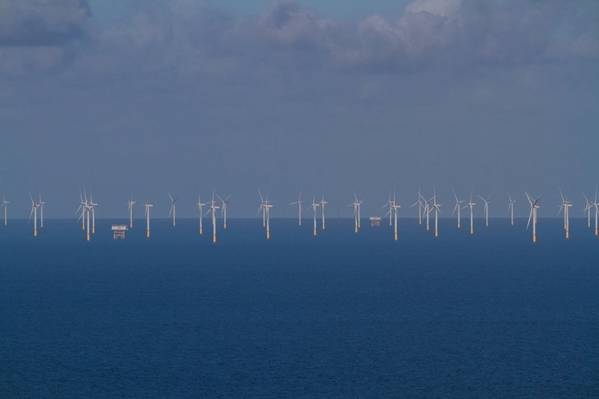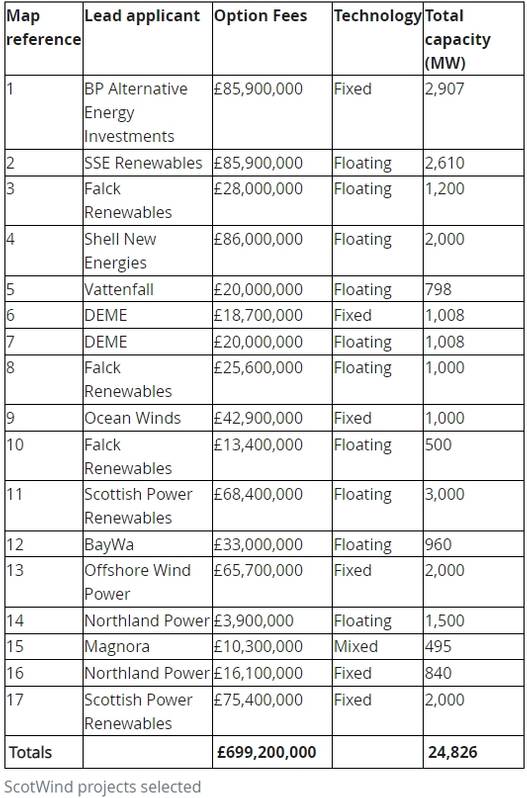
BP, Shell, and utility Iberdrola were among the winners of seabed rights to develop Scottish offshore wind projects, in an auction that raised nearly 700 million pounds ($958 million) for public spending.
Competition for offshore wind sites has intensified as governments and investors have woken up to the urgency of cutting carbon emissions, with oil majors making high bids.
Crown Estate Scotland, which manages the Scottish seabed, said on Monday that proceeds from the first such leasing deal in around a decade will go to the devolved Scottish government.
The 17 winning Scottish projects will produce nearly 25 GW in the next decade, helping to provide low-carbon power in line with a UK-wide goal to cut emissions to net zero by mid-century. Credit: Crown Estate Scotland
Credit: Crown Estate Scotland
A gigawatt equates to roughly two coal-fired power plants and is enough to power 750,000 homes in Britain, where the overall power demand can be between 20-47 GW per day, depending on the season. Around 35% of the country's electricity generation is already generated from renewables.
Power generated in Scotland, where the population is much smaller, is brought ashore on the Scottish coast via underwater cables and connected to the national electricity grid.
Crown Estate Scotland said there were 74 applications from developers seeking to build projects across 15 areas of seabed and option agreements have been made to companies including BP, SSE, Shell New Energies, Iberdrola's Scottish Power, TotalEnergies and Vattenfall.
The biggest winner was Scottish Power Renewables, which has the go-ahead for projects totaling seven gigawatts (GW).
They include a joint venture with Shell to develop the world's first large-scale floating wind farms at two sites with total capacity of 5 GW.
Thomas Brostrom, senior vice president of global renewable solutions at Shell told Reuters it was too early to say exactly how much it would invest: "It's clear you are looking at multi-billion pounds for the construction of these wind farms."
The projects include six fixed offshore wind, 10 for floating wind and one mixed.
Crown Estate Scotland said it only grants full seabed leases when developers have all the necessary consents and planning permissions from the Scottish government and other bodies.
But should any application not progress to signing a full agreement, the next highest scoring application will instead be offered an option.
Last year, seabed options around the coast of England, Wales and Northern Ireland were awarded at much higher prices at a leasing round held by the Crown Estate.
However, Crown Estate Scotland capped the lease payments at 100,000 pounds per km2. As a result the payment for leases per GW were 94% lower than the average in the English auction, said analysts at Bernstein.
A joint venture between BP and Germany's EnBW were successful in bid for a 2.9 GW wind project which BP previously said would result in 10 billion pounds of total investment.
BP opted to bid for fixed-bottom rather than floating sites, adding that it would not rule out looking at the technology.
“We always said within the BP financial frame we are looking at returns of between 8-10% and this [Scotwind, fixed-bottom project] fits well within that frame,” Louise Kingham, BP UK country chair, told Reuters.
The world's largest developer of offshore wind, Orsted, had submitted five bids either alone or through joint ventures but was only awarded one option agreement for a 1 GW project together with partner Falck Renewables among others.
($1 = 0.7312 pounds)
(Reporting by Nina Chestney; additional reporting by Christoph Steitz, Susanna Twidale, Stine Jacbonsen, Ron Bousso, Dominique Vidalon; Editing by Kirsten Donovan, Emelia Sithole-Matarise, Barbara Lewis and Alexander Smith)